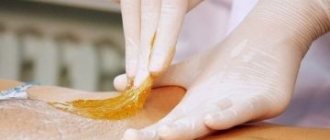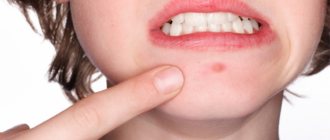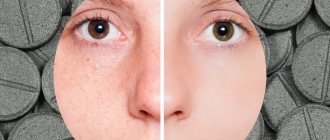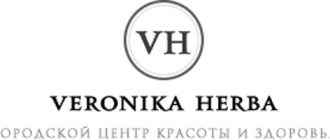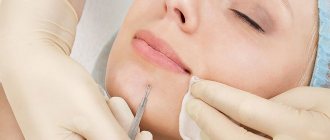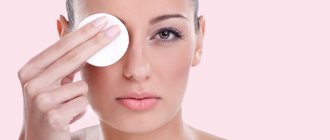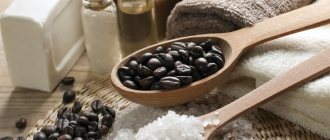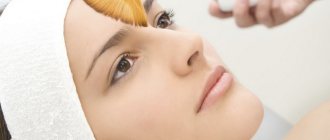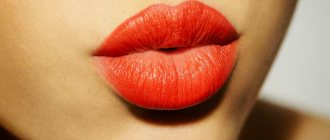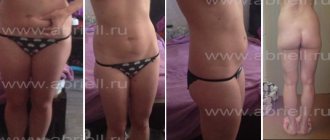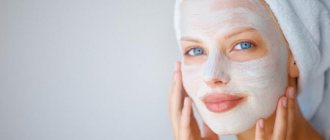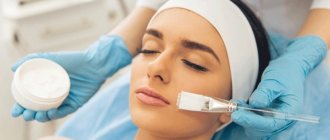Reasons for appearance
In adolescents starting from the age of 12, the main cause of the appearance of blackheads is considered to be hormonal changes in the body. In older age, the cause of comedones may be poor nutrition or poor skin care. Blackheads, unlike other skin rashes such as acne, rarely become inflamed.
The formation of blackheads occurs due to clogging of pores with secretions of the sebaceous glands and street or household dust, as well as oxidation under the influence of oxygen, as a result of which the skin pore becomes dark gray or black.
Often, to get rid of comedones, it is enough to change your diet, excluding fatty, floury and sweet foods from the menu.
Why do acne vulgaris form?
In the pores of the skin there are hair follicles, into the lumen of which the ducts of the sebaceous glands open. Thus, the secretion synthesized by the sebaceous glands (sebum) is first poured into the lumen of the hair follicle, and then excreted onto the surface of the skin. The physiological significance of the secretion of the sebaceous glands is to moisturize the skin (by reducing the evaporation of moisture from its surface), as well as improving its barrier properties. The reasons for the formation of acne vulgaris on the face are as follows:
1) Hyperactivity of the sebaceous glands –
The activity of the sebaceous glands is controlled by hormones. The greatest activity of the sebaceous glands is observed in the puberty period (puberty) - this is the time period from 12 to 16 years in girls, and from 13 to 17-18 years in boys. This occurs due to an increase in the level of androgens in the blood - primarily testosterone. The latter can be of either testicular (in boys) or ovarian origin (in girls). Thus, the first reason may be due to high concentrations of androgens.
But the concentration of androgens can be increased not only in adolescents, but also in adults (absolute hyperandrogenism). In addition, in women, the activity of the sebaceous glands is also associated with the cycle; for example, it always increases after ovulation, which is associated with an increase in the concentration of luteinizing hormone. Therefore, in the period from 2 to 7 days after ovulation, acne may appear or worsen in women. But still, in most people with acne (blackheads and pimples), an increase in the concentration of androgens is not laboratory confirmed, but there is hyperactivity of the sebaceous glands.
The latter has its reason. The fact is that a number of patients may experience an increase in the sensitivity of receptors located in the sebaceous glands to androgens. In turn, this leads to increased production of sebaceous gland secretions (even with normal concentrations of androgens in the blood). Increased receptor sensitivity is provided by enzymes such as 17-β GSD, 3-β GSD, and 5 α-reductase. The first 2 enzymes convert dehydroepiandrosterone and androstenedione into testosterone, and then 5 α-reductase converts free testosterone into dihydrotestosterone.
Thus, due to the increased activity of enzymes, the concentration of dihydrotestosterone increases (even with normal levels of androgens in the blood). Dihydrotestosterone is a direct hormonal stimulator of the synthesis of sebaceous gland secretions (sebum). In patients with acne and pimples, the biosynthesis of dihydrotestosterone in the sebaceous glands is increased from 2 to 30 times compared to patients with healthy skin. Moreover, in men this process occurs much more intensely (24stoma.ru).
Important: overactivity of the sebaceous glands has another important consequence. The fact is that an increase in secretion leads to a change in the qualitative composition of sebum, namely to a decrease in the content of linoleic acid in it. We will explain below what this affects.
2) Follicular hyperkeratosis –
We have already said that the skin pore is the lumen of the hair follicle (the so-called “follicular canal”). The peculiarity of the latter is not only that the duct of the sebaceous gland opens into it and sebum is separated. The walls of the follicular canal are covered with a thin layer of follicular keratinocytes (corneocytes). Renewal of cell layers occurs with desquamation of the latter, i.e. they are exfoliated and enter the lumen of the hair follicle, and then, together with sebum, are carried to the surface of the skin.
There is such a thing as follicular hyperkeratosis. This process consists of increasing the proliferation (reproduction) of the deep layers of keratinocytes, and slowing down their desquamation (desquamation) into the lumen of the hair follicle. First of all, this occurs due to androgenic stimulation, as well as the low content of linoleic acid in sebum. In addition, follicular hyperkeratosis is also caused by the release of an inflammatory mediator called IL-1 (interleukin-1) by follicle keratinocytes. This inflammatory mediator is released by keratinocytes, also in response to overproduction of sebum by the sebaceous glands.
And now we come to the point that it is “increased amount of sebum + follicular hyperkeratosis” that are the main processes that lead to obstruction of hair follicles in the pores of the skin (i.e. to the formation of “sebum plugs” in their lumen - open and closed comedones).
White and blackheads: photos
3) Epidermal hyperkeratosis –
But hyperproliferation of keratinocytes and disruption of their desquamation can occur not only in hair follicles, but also in the epidermal layer of the skin. Epidermal keratinocytes, for example, also have androgen receptors, as do hair follicle keratinocytes. An increased concentration of androgens, or increased sensitivity of receptors to androgens, leads to hyperproliferation of keratinocytes, as well as increased synthesis of keratin, as well as glycosaminoglycans, which are one of the main components of the bonding cement between keratinocytes.
As a result of cement strengthening, the separation of keratinocytes in the stratum corneum (corneocytes) is disrupted, which leads to a decrease in their exfoliation and an increase in the thickness of the stratum corneum. The latter can block the mouths of the hair follicles, making it difficult for them to eject the secretion of the sebaceous glands (sebum) onto the surface of the skin, which contributes to the formation of sebaceous plugs. But epidermal hyperkeratosis can also be associated with excessive exposure to solar radiation, which also leads to an increase in the thickness of the stratum corneum. There is even such a term as “sun acne” (Favre-Rakucho disease).
Acne on the face: predisposing factors
In addition to the main factors for the appearance of acne, there are also secondary ones that predispose to their appearance. We have listed the main ones below:
- Comedogenic cosmetics – cosmetics can cause acne if they are oil-based and can clog pores. Examples of comedogenic components are various natural oils, as well as various emollients derived from petroleum (for example, isopropyl myristate and its analogues). It is advisable to choose cosmetics that have been tested for comedogenicity, which will be marked as “non-comedogenic”.
- Birth control pills and hormonal changes - we already wrote above that the appearance and intensification of acne in women (in the period from 2 to 7 days after ovulation) can be associated with the cycle. Additionally, birth control pills can also stimulate acne, but only if they contain only pure progesterone.
- Medicines – the appearance of acne on the face can be stimulated by anticonvulsants, bromides, lithium, iodides, isoniazid, corticotropin, prednisolone or its analogues, as well as steroid hormones. In addition, according to the world's most famous textbook on dermatology, Fitzpatrick's Dermatology, such a reaction is possible to the use of a complex of B vitamins, and in addition to the so-called “halogenated compounds” (the latter are widely used in the production of drugs and dyes).
- Increased sweating – if due to physiology, or due to increased physical activity or work conditions, you often sweat, this can aggravate your acne.
Important: the influence of many other factors is discussed in the literature. One of the false prejudices is that acne and pimples can be associated with Demodex folliculorum mites (and this is certainly the work of medical representatives who instill this in pharmacies). This type of mite may indeed be present in the hair follicles, but its presence does not play any significant role in the development of acne. And besides, these mites are generally extremely rarely found in young people.
Another false statement is the influence of slagging in the body and intestines in particular, and the need to take, God forgive me, adsorbents! Of course, such theses are also disseminated by medical representatives of pharmaceutical companies, and you can also read about this in numerous comments written by employees of marketing agencies under the guise of ordinary forum visitors. This is called “medical marketing” (hidden advertising of pharmaceuticals on forums), and the vast majority of pharmaceutical companies do not disdain this.
Diet: as for diet, today there is not a single serious clinical study that would reveal the dependence of acne on dietary habits. The influence of consumption of foods with a high glycemic index, as well as fatty foods, milk, chocolate and other carbohydrate-rich foods on the aggravation of acne is still being discussed. At least to date, the connection of these products with acne and pimples is considered unproven. Next we will talk about how to get rid of acne.
Cleansing
In people suffering from increased sweating and sebum secretion and, as a result, oily skin, fat plugs form, which become especially noticeable in the nose area.
It is impossible to get rid of the problem once and for all, but daily, systematic cleansing and the use of pigment-constricting drugs will make the skin clean and healthy. It is recommended to carry out such procedures daily, so it is better to do them at home.
How to squeeze out blackheads on the nose yourself, using available means and methods? Facial cleansing is the main way to combat blackheads; regular cleansing will keep your skin clean and healthy. Cleaning is mainly done by squeezing; this can be done at home. But to do this, you should take care of disinfecting the devices by first disinfecting them with medical alcohol.
Before squeezing out blackheads on your nose, you need to properly steam your face so that the pores open and the fat plugs come out after light pressure.
Possible consequences
The most common complaints are about redness and possible inflammatory processes after squeezing out comedones. You can prevent them, you just need to maintain sterility and use gentle means.
Inflamed skin can be treated with an antiseptic, decoctions of pharmaceutical herbs with a similar effect, as well as special anti-inflammatory agents.
Getting rid of comedones on the face is not an easy task, which can be overcome through complex therapy. Self-removal of open comedones or so-called blackheads is a risky procedure that can cause a negative effect. If everyone is determined to do this at home, the advice in our article will come to the rescue. Treatment of closed comedones on the face is described in detail in this material.
Steaming
Method one: steam bath. For the procedure, you will need to boil water in a saucepan, add a pinch of oak bark, chamomile, sage, a couple of drops of eucalyptus essential oil, tilt your face over the saucepan, cover your head with a thick scarf or towel and breathe over the hot steam for ten to fifteen minutes.
Method two: warm mask. For this procedure, you should purchase skin care products that have a steaming effect, for example, warming strips, scrubs, masks, in advance at a pharmacy or store.
Method three: hot compresses or visiting a sauna. During hygiene procedures, hot steam opens the pores; you can use a compress of thyme or chamomile, soaking it in herbal infusion every 2-3 minutes.
Mechanical cleaning
It is important to know how to properly squeeze out blackheads on the nose. After the skin on the face has steamed and the pores have opened, you can begin the procedure of cleansing the epidermis of blackheads.
Stages:
- Cleansing your face with a scrub or foam.
- Disinfection of hands washed with soap and medical alcohol.
- Preparing the face for the procedure by steaming using baths or warming masks.
- Before cleaning, wrap your fingers in sterile gauze or a bandage soaked in hydrogen peroxide.
- You need to remove comedones by gently pressing your fingers on both sides.
- After cleansing, wipe your face with hydrogen peroxide and apply a pigment-constricting lotion.
- It should be remembered that after the procedure it is not recommended to apply greasy creams or decorative cosmetics.
In addition to manual cleaning, blackheads on the nose can be squeezed out with tweezers and a cosmetic loop. They should also be disinfected before the procedure.
Is it possible to squeeze out a comedone?
Despite the warnings of cosmetologists, the most popular home procedure for many people is the periodic squeezing of pimples and blackheads. This is not recommended, as this can lead to the deepening of the inflammatory “core” into the lower layers of the epithelium and the development of the inflammatory process already there.
Professional facial cleansing, in turn, is also not an easy procedure, requiring a certain professionalism of the performer. The reputation of the salon where this cleaning is performed also plays a big role. You should not give preference to low cost and perform cleaning sessions in dubious premises or “at home”. The risk of contracting any unpleasant and dangerous disease in this case will be unjustified; it is better to carry out such a procedure yourself.
Find out what pimples on your temples mean.
Here are the causes of acne under the jaw.
Reviews on the use of toothpaste for acne on the face: .
Cleaning your face with a pen rod
Before squeezing out blackheads on your nose with a pen rod, you need to steam your face over steam so that the pores open and the sebaceous mass becomes more pliable. Cleaning is carried out with a simple ballpoint pen; it should be no more than 3 mm in diameter.
The rod must be disinfected, this can be done using a tonic with a high alcohol content. The pen shaft should be placed on the black dot, adjusting the degree of pressure, you need to carefully pull out the dot. Here the tube acts as a vacuum pump, drawing the sebaceous mass inside. If anything remains under the skin, the procedure can be completed by manual cleaning.
To prevent the reappearance of blackheads, you can apply a restorative, pore-tightening one-component mask to your skin. To do this you need to: beat the chicken protein into a thick foam, spread it on your face in three layers, applying each layer after the previous one has dried. Rinse off with cool water after twenty-five to thirty minutes. To ensure that the mask has a pore-tightening effect, you can add one teaspoon of freshly squeezed lemon juice to the whites when whipping. The procedure must be repeated every two days for a month.
Useful tools and are they needed?
It seems that every person has tried to squeeze out open comedones with their fingers at least once in their life. By and large, this method copes with the task quite well and therefore has a right to exist. The only condition is not to take it lightly. You can’t walk past a mirror and stop for a minute and start cleaning your face! Required:
- remove makeup, wash and steam the skin with a steam bath or compress from a towel soaked in hot water;
- wipe your face and hands with a disinfectant liquid such as chlorhexidine or calendula tincture;
- It is very advisable to wrap your fingers in a sterile napkin or bandage, which, firstly, will serve the cause of hygiene, and secondly, will protect the skin from the nails.
And then everything is elementary: press the pads of your fingers to your nose on both sides of the black dot and begin to press until the plug with the dark head is on the surface. Remove it, and at the end of the procedure, disinfect the skin again.
Those who believe that their fingers are not able to cope with cleaning efficiently use a variety of tools, both made from improvised means and special ones.
Pen refill
Turn a disassembled writing pen into a vacuum pump to clean out your pores? Why not! To do this, wipe the rod with alcohol, turn the writing side away from you, press it to the steamed skin exactly above the blackhead and slowly press. If everything is done correctly, the sebaceous plug easily slides out of the pore.
It is more convenient to use the rod on the back and shoulders than on the face
The method is quite controversial. I never managed to master it, despite three disassembled pens with rods of different diameters - the black dots stubbornly ignored all my attempts. But who knows, maybe the comedones will submit to the rod in your hands?
Matches
The idea is simple: squeeze out comedones by pressing on the nose heated with a hot towel, not with your fingers, but with two matches held in your hands. The pressure turns out to be more directed, almost point-like, and the effect of the procedure increases.
And this is where I failed. Poking your own nose with the clean ends of matches was painful, and with heads of sulfur it was scary (you never know, maybe particles of sulfur would remain in the pores). In a word, matches turned out to be ineffective against fingers. At least for me.
Dental floss
The bright idea of getting comedones out of your pores by scraping your nose with dental floss on a plastic holder first came to the mind of a girl blogger from California and has been going around the world ever since. Removing blackheads occurs as follows: take a steam bath for the face to open the pores and soften the sebum, then press the thread tightly to the bridge of the nose and with moderate pressure lead to the tip of the nose. All the sebaceous plugs encountered along the way pop out on their own.
Move the thread smoothly, in one motion, without staying in one place for too long
This time the experience was more successful and the pores were partially cleared. But I still remained committed to the “finger method”. I think it works cleaner.
Tweezers
By itself, it is useless for squeezing out blackheads, but some people manage to make the cleaning deeper by grabbing the head of a plug partially squeezed out with another tool with tweezers and pulling it out entirely.
But the advice to rub your nose with a toothbrush to remove sebum from clogged channels, which is often found on the Internet, is rather harmful. This way, you are much more likely to get scratches and visible spider veins than to get rid of comedones.
Spoon
The modern cosmetics industry suggests using not only tonics, patches and masks, but also devices for mechanical facial cleansing to combat comedones. Most often, they look like a rod, at one end of which a kind of “spoon” with holes is attached, and at the other - a loop or needle. By pressing one or the other tip on the skin in the area of the comedone, it is squeezed out to the surface almost entirely.
The metal loop is more effective than thread, fingers and tweezers
Video: dermatologist's recommendations
Unfortunately, blackheads cannot be removed once and for all; they will appear as long as you have sebaceous glands. But you can minimize the problem by adjusting your diet, giving up bad habits and checking your cosmetic products (for example, expensive organic creams often contain animal lanolin, which clogs pores). If necessary, it doesn’t hurt to visit a doctor: sometimes it’s impossible to get your face in order without consulting not only a cosmetologist, but also a gynecologist, gastroenterologist and other specialists.
- Author: Svetlana Rozhenko
My name is Svetlana Rozhenko. 33 years old, psychologist by training. Rate this article:
- 5
- 4
- 3
- 2
- 1
(1 vote, average: 5 out of 5)
Share with your friends!
Removing blackheads with matches
Before squeezing out blackheads on your nose with matches, you need to prepare your face. Two to three days before the procedure, apply tea tree oil lotion and a green tea mask with honey to the problem area. To prepare the lotion you will need: six drops of tea tree oil, two tablespoons of boiled water. To achieve maximum effect, it is recommended to wipe your face with lotion twice a day; in addition, you can add tea tree oil to water and hold your face over the steam, this manipulation will be no less effective. The same tea tree oil can also be used as a disinfectant.
Green tea mask with honey. To prepare the mask, you need to mix four teaspoons of honey, four tablespoons of sugar, one and a half teaspoons of apple cider vinegar, two tablespoons of green tea. Apply the finished mask to your face for fifteen minutes, then rinse with warm water.
Before cleansing your face, you need to thoroughly steam the area around the nose and disinfect it, then use clean matches from the box to press on the area around the comedone. Using two matches, pressing the match head on the blackhead, you should carefully pull out the sebaceous mass. If the skin is well steamed, there will be no problems during the procedure. After manipulation, it is recommended to lubricate the inflamed areas with salicylic or syntomycin ointment.
Dry cleaning and cosmetics
There are different ways to squeeze out blackheads on the nose:
- Chemical cleaning: cleansing occurs through the application of a special composition - a mask containing fruit acids. Under the influence of glycolic acid, the pores open, dissolving the fatty cores of blackheads.
- Cosmetics: there are no universal means for carrying out an effective procedure at home, but compositions of triothioin, azelaic acid, and defirin, which have the ability to normalize the functioning of the fatty glands, can be considered effective. Zinc or salicylic acid will help reduce inflammation. Using products with such components regularly, you can achieve a good effect - scars will heal, and acne and blackheads will gradually begin to disappear.
- Cleansing mask: for preparation you will need baking soda and baby soap. Apply soap, whipped into foam, onto the face in the first layer, baking soda is poured in the second layer. If the skin begins to turn red or tingling begins, the mask should be washed off immediately and the next time repeat the session after seven to ten days, reducing the amount of soda.
Often, at an appointment with a cosmetologist or on forums, visitors ask the question: “Is it possible to squeeze out blackheads on the nose?” It’s definitely possible, but it needs to be done correctly, using only sterile equipment. However, there are circumstances under which mechanical facial cleansing is prohibited.
Contraindications:
- Second and third trimester of pregnancy.
- Infectious diseases.
- High or low blood pressure.
- Weak blood vessels and capillaries.
- CNS dysfunction, epilepsy.
- Chronic dermatological diseases.
- Bronchial asthma.
How to squeeze out blackheads on the nose if manual cleaning is contraindicated? You can use more gentle methods, for example, masks, scrubs, brossage or ultrasonic cleaning.
Consequences of mechanical cleaning
The disadvantages of getting rid of blackheads include:
- A long period of skin renewal and restoration - from three to ten days.
- The appearance of scars and cicatrices if the procedure is carried out incorrectly.
- Possibility of infection or infection of the wound.
- The appearance of itching and rashes after poor cleaning.
Also, significant disadvantages include such a problem as deep-lying fatty tubules in the pores.
How to squeeze out blackheads on the nose if they don't squash? Contact a cosmetologist who will perform deep ultrasonic cleaning and clog the pores, after which they will become less deep, and next time you can cleanse yourself at home. After the procedure, for two to three days it is not recommended to: use decorative cosmetics, drink alcohol, play sports or fitness, visit baths or saunas, wash your face with hot water, sunbathe in the sun or visit a solarium.
Features of removing blackheads on the nose
It seems that the nose is a very convenient place to deal with blackheads. Here it is much more convenient to push comedones to the surface by pinching the skin on both sides of the pore than, for example, on the cheeks or in the lip area. Lips, by the way, are also areas with very thin skin, which aggressive finger movements can stretch and nails can injure. But that’s probably where the advantages of the nose end.
Squeezing out comedones on the nose is more convenient, but inflammation often occurs.
The disadvantages are the abundance of nerve endings, which if pressed down, you are guaranteed to give yourself very unpleasant sensations. And the skin of the nose, despite its apparent density, is easily susceptible to injury, so even such a simple procedure as squeezing can leave a scar on it. And if you do happen to get an infection in your pores, an inflamed pimple swollen on your nose will be noticeable to everyone around you.
Advice: if you are planning to cleanse your skin of blackheads, do it on Saturday or in the morning on Sunday so that you can be at home and not scare others with a purple nose while your face returns to normal.
Blackheads in children
Children often develop acne or blackheads starting from birth; this most often occurs due to poor nutrition or child care. Often concerned about a skin rash atypical for a child, parents ask the dermatologist the question: “Is it possible to squeeze out blackheads on a child’s nose?”
If the child has not reached adolescence, you should not visit a cosmetologist; the pores of children at this age are quite dense, and there cannot be contamination with dirt. You can get rid of the rash by removing dense fats from your child’s diet and adding B vitamins and zinc.
